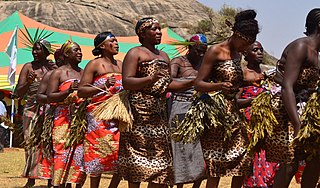Related Research Articles
Ga is an Afro-Asiatic language spoken by about 500,000 people in the Gombi Local Government Area in Adamawa state of Nigeria. Many speakers live across the length and breath of Nigeria. It has three dialects, Ga'anda, Gabun and Boga; Blench (2006) classifies Gabun is a separate language. Its speakers are generally not monolingual in Ga'anda, instead, they use Hausa, Lala, Hona, Kilba, Fulfulde, and Bura. Ga'anda has a rich cultural heritage, its natives are very hospitable people. 70% of its population are Christians, 20% Muslims and 10% Traditionalists.
Mwaghavul is an Afro-Asiatic language spoken in Plateau State, dominantly in

Bata (Gbwata) is an Afro-Asiatic language spoken in Nigeria in Adamawa State in the Numan, Song, Fufore and Mubi LGAs, and in Cameroon in North Province along the border with Nigeria. Dialects are Demsa, Garoua, Jirai, Kobotachi, Malabu, Ndeewe, Ribaw, Wadi, and Zumu (Jimo). It is often considered the same language as Bacama.
Guduf-Gava is an Afro-Asiatic language spoken in Borno State, Nigeria. In a 2006 paper, Roger Blench classified Cineni as a dialect.

Ron is an Afro-Asiatic language cluster spoken in Plateau State, Nigeria. Dialects include Bokkos, Daffo-Mbar-Butura, Monguna. Blench (2006) considers these to be separate languages.
Dass is an Afro-Asiatic dialect cluster spoken in Bauchi State and Plateau State, Nigeria.
Ebira is a Niger-Congo language. It is spoken by around 3 million people in North central Nigeria. It is the most divergent Nupoid language.
Zeem, or Chaari, is an endangered Chadic dialect cluster of Nigeria, whose speakers are shifting to Hausa. Dyarim is closely related.
Jarawa is the most populous of the Bantu languages of eastern Nigeria. It is a dialect cluster consisting of many varieties.
The East Kainji languages are spoken in a compact area of the Jos Plateau in Nigeria, near Jos. There are more than 20 of them, most of which are poorly studied.
The Koma language is a language cluster belonging to the Duru branch of Savannas languages of Cameroon. Blench (2004) includes three varieties separated in Ethnologue, Koma Ndera, Gɨmne, and Gɨmnɨme; within Koma Ndera, speakers of the marginal dialects, Gomnome and Ndera, can scarcely understand one another, though both understand the central dialect, Gomme.
Mboi is an Adamawa language of Nigeria. Its name is that of one of its dialects, the other two being Banga and Handa. These are rather divergent, Blench (2004) considers them to be distinct languages.
Berom or Birom is the most widely spoken Plateau language in Nigeria. The language is locally numerically important and is consistently spoken by Berom of all ages in rural areas. However, the Berom are shifting to Hausa in cities. The small Cen and Nincut dialects may be separate languages. Approximately 1 million (2010) people speak in this language.
Gbantu (Gwantu) is a dialect cluster of Plateau languages in Nigeria. Gwantu is the name of the principal dialect; the others are Numana, Janda and Numbu.
Jukun (Njikun), or more precisely Jukun Takum, is a Jukunoid language of Cameroon used as a trade language in Nigeria. Though there are only a few thousand native speakers, and only a dozen in Nigeria, it is spoken as a second language in Nigeria by tens of thousands.
Ubaghara is an Upper Cross River language of Nigeria. 80% of speakers speak the principal dialect, Biakpan.
Zari (Zariwa) is a Chadic dialect cluster of Nigeria. Blench (2019) lists varieties as Zari, Zakshi, and Boto.
Yala (Iyala) is an Idomoid language of Ogoja, Nigeria. Blench (2019) lists dialects as Ikom, Obubra, and Ogoja.
Kakanda is a Nupoid language of Nigeria. Kakanda is spoken in and around Kupa and Eggan. There are scattered villages stretching from the Niger-Benue confluence to as far as Muregi. There are at least 10,000 people. It is most closely related to Gupa and Kupa, although there are also some similarities with Ebira.
Lere is a nearly extinct Kainji dialect cluster of Nigeria. The ethnic population was cited as 16,000 in 2000, of whom only a few speak the language. A wordlist from the Takaya dialect can be found under External links.